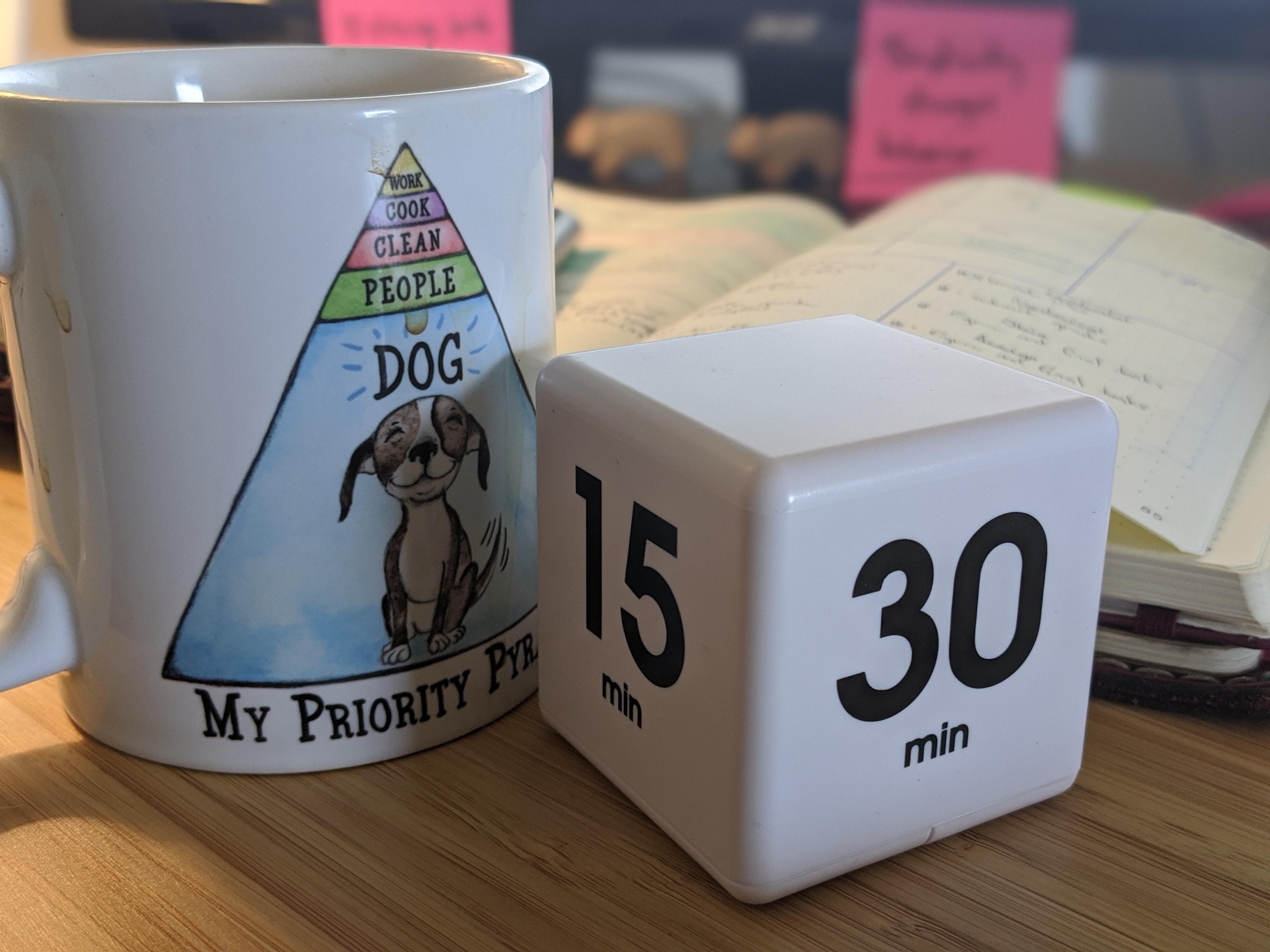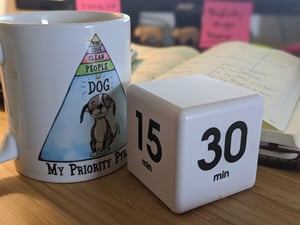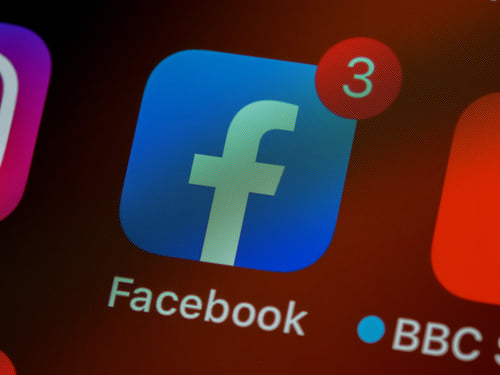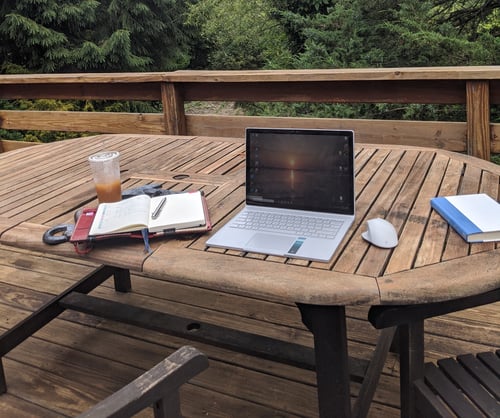
Working From Home is the New Normal
 I have some experience working from home. About seven years' worth. Now that we're all doing it, I figured I would let you in on how I'm able to work from home everyday without losing my mind.
I have some experience working from home. About seven years' worth. Now that we're all doing it, I figured I would let you in on how I'm able to work from home everyday without losing my mind.
Here are some of the tips, habits, tools and techniques I've used for my consulting and web design business.
Get Dressed (at least a little)
Nothing tells your brain that you can slack off all day like staying in your PJs. Have I worked in my PJs before? Of course. Was I productive? Hell no.
Now, these days I often work in my joggers or PJ pants, but I almost always put on a different top. Plus, given what I do for my clients, you never know when you'll need to hop on an unscheduled Zoom call.
Figure out your work trigger
Every morning I make coffee, or at least I drink it. Having my cup of coffee next to me while I'm working is my trigger to sit down and get stuff done. More often than not, my coffee gets cold when I get into the work zone, so I probably need to invest in one of those USB mug warmer things.
Regardless, figure out what you do normally at the beginning of your work day. Is it the commute that gets your brain into work mode? Go for a short drive and listen to a podcast, or a walk, or brew some coffee AND go for a walk or drive.
Establishing habits, like habitually being at your best for the workday, starts with a trigger. Figure out what the hook was pre-pandemic and mimic it now.
By the way, if you've found this content useful, you can subscribe to get new posts via email.
Change your locale
I don't always work from my desk. Before, I used to go to the local cafe a couple of times per week, and was incredibly productive there. Nowadays I can only order their coffee online and pretend, but I'm not chained to my desk. Other options are my dining table, the couch, my porch and even my car.
Yes, sometimes I'll get dressed, make coffee and bring my bullet journal with me on a car ride to do some non-computer work. Nothing like looking at the ocean in Gloucester to think more creatively.
Be a little social
I don't have as many meetings as some of you, so I'm not totally Zoomed out, but I do make it a point to be a little social. Whether it's calling up my other half to chat while we're both working, or talking to family about the latest life project I'm working on, I'm making it a point to talk to people about non-work stuff.
Also, I've started writing letters to pen pals. There's a Facebook group for that.
Create your master calendar
Years ago I learned about the idea of a 'master calendar.' That's when you create recurring events on your calendar that should or have to happen each week. Also known as time blocking, or calendar chunking.
For example, Monday mornings are spent working on my own business stuff, whether it's administrative or writing, I don't work on client tasks. Tuesday afternoons are blocked out for recurring client meetings, and Friday afternoons are for planning the next week and wrapping up little tasks that popped up throughout the week.
In between are chunks of time I block out for specific projects or clients. I also make it a point to block out time everyday for a break. The idea is that generally every week will look the same, so you have a base to start with and you can adjust as needed.
Write it out
I don't always write everyday, but on the days I do, I mentally feel better about whatever is going on. It took a long time to get to feeling like I can handle whatever happens, and writing has been the key to that. I'll either write some morning pages (writing about whatever first thing in the morning) or a letter to a pen pal. Handwriting works best for me, but there are a ton of apps for writing online. I used to use Day One, but now I'm back to pen and paper.
Use a timer and walk away from your desk
I use the Pomodoro technique, which is working on one specific task or project for a bit, then taking a break. Specially I use a cube-shaped timer with various time options on it, and work in 30 minute stints (unless I'm in flow) and 5 minute breaks. I also block out an hour or two in the middle of the day to do something else, preferably outside.
I'll either go for a walk with my pups, take a ride on the moto or if it's particularly crappy out, drive my car or suck it up and hike in the rain. I find doing this, especially on days with a lot of meetings, allows me to have a mid-day recharge.
Be honest
I used to be terrified to have a bad day. A bad day means unproductive and wasted time. When I did primarily hourly work, it meant being in a funk for a day cost me money. The truth is, being honest with yourself about what's going on in life or in your mind, and then sharing that honesty with your clients, frees you up to do the things that get you back on the path.
Less worrying about the impact and more focus on the solution.
Now, not all clients need to or get to know the nitty gritty, but a simple hey, today's shitty, or hey, I need to refocus or reprioritize some stuff so I can do better for you in the future works wonders.
Reset goals and create small wins
At the start of this year, I had so many goals. Be outside was the underlying theme. I planned for backpacking and motocamping trips, vacations with my S.O. and doggos, and work on my school bus turned camper. Lots of fun.
Then...well you know. I've had to adjust. I've turned to focusing on the little things I can do, like tackling the random piles of stuff that has collected in my office, or exploring new roads and trails on two wheels, solo. Also, cooking more at home...because I have to.
Every week I try to create something to look forward to, like going to the empanada food truck on Friday nights, setting a new distance challenge for a hike or actually finishing a book.
Plan
Either before I stop working for the day, or at the beginning of a new day, I write out my goals for that day. I usually have five major tasks or projects I want to accomplish, with a smattering of other things. If I can get those five done, then it's a great day and I've moved the needle for my clients.
You don't have to use the bullet journal method like I do, but a simple notepad with your top 3-5 tasks, in plain view all day, will help keep your focus on what matters.
Stop working
You can ignore everything above and only follow this one thing for creating sustainable work from home habits.
Stop working. Set boundaries.
Do I check my email at 8pm on weeknights? Often. But I snooze them until the morning and don't worry about them again. Rarely do I get the "my website is on fire" emails these days, and when I do, I handle it. More often than not it's vital I turn work-mode off and create a buffer before the next day.
I know this is probably the tenth blog post like this you've read, but I hope you picked out a new thing to test out as we all go through working from home, together.
I help businesses and marketers build marketing and sales systems that drive leads and scale with ease.
Not sure where to start? Take my marketing quiz and get personalized next steps.



